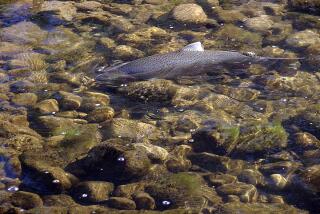Poisoning a Sierra stream to save the world’s rarest trout
WALKER, Calif. — State fisheries biologist Dave Lentz poured poison into a remote High Sierra stream and watched quietly as every rainbow and golden trout in the water turned belly up.
After the rotenone spread along 11 miles of Silver King Creek last Wednesday, other biologists poured in a neutralizing agent, making the river again habitable — and a suitable home for the rarest trout in the world.
Kneeling beside a small brass spigot that dripped the milky white toxin into a pool edged with alders, Lentz, a conservation coordinator for native trout with the California Department of Fish and Wildlife, smiled and said, “Looks like everything is working as intended. The Paiute cutthroat trout belongs in this stream, not the nonnatives in here now.”
The Paiute trout is native to the Alpine County stream in the Eastern Sierra’s Carson-Iceberg Wilderness of the Humboldt-Toiyabe National Forest. But it had been squeezed out by rainbow and golden trout, which are not native to this portion of Silver King Creek.
The plan to restore the Paiute trout had been held up in federal court for more than a decade by opponents who believe that poisoning a stream is about the worst thing that could happen in a designated wilderness. They also question the safety of rotenone and worry about its possible long-term effects on wildlife and regional water supplies.
Biologists say rotenone is a natural poison derived from peas that breaks down rapidly and poses no threat to water supplies.
After the poisoning, biologists in waders sloshed in knee-deep water, using nets to scoop up the trout and place them in buckets. The remains were to be tossed into the forest as an unexpected banquet for insects, birds and mammals.
Alpine County Supervisor Don Jardine is among the critics of this recovery effort by the state Department of Fish and Wildlife, the U.S. Forest Service and the U.S. Fish and Wildlife Service. Jardine first fished this wilderness with his father more than half a century ago.
“I have a basic philosophical objection to anyone polluting a natural waterway,” Jardine said. “Beyond that, these agencies are taking the easy way out. They could have used less obtrusive alternatives such as electroshock, but that would have required more time, money and manpower.”
Jardine also pointed out that rotenone is banned for use in U.S. coastal waters and banned entirely in Europe. Also, some rotenone treatments have flopped.
In 1992, an estimated 1,000 trout were accidentally killed along a different stretch of Silver King Creek when state wildlife biologists mistakenly used excessive amounts of potassium permanganate to neutralize rotenone.
In the late 1990s, state wildlife authorities laced the Sierra reservoir of Lake Davis with rotenone as part of an effort to eradicate northern pike, an invasive saw-toothed fish that had been ravaging the lake’s trophy-size trout. The pike returned in 18 months.
In May, however, a U.S. District Court judge green-lighted the Silver King Creek project. It is intended to create a self-sustaining population of about 2,500 Paiute cutthroat in seven to 10 years, making the species eligible to become the first fish ever removed from protection under the Endangered Species Act.
“Rotenone is as close to a silver bullet as anything we have in that it hardly impacts anything but fish,” said Dan Duffield, a U.S. Forest Service fish biologist. “In this case, we’re using it to restore an extremely rare fish in an area where it evolved with other creatures such as mountain yellow-legged frogs.”
Since the 1960s, mountain yellow-legged frogs have been decimated in the Sierra Nevada by predators including nonnative fish.
The historic range of the Paiute cutthroat is thought to have been limited to about 9 miles in Silver King Creek. By the early 1900s, the species was in danger of extinction through interbreeding with hybridized nonnative trout.
The Paiute cutthroat’s range was extended into the upper reaches of Silver King Creek — inaccessible to nonnative trout — via unofficial transplantation of the fish by Basque sheepherders in 1912. The Paiute descendants are the only known pure strain of the iridescent purplish trout.
Because the Paiute cutthroats readily take a lure or a fly, Silver King Creek was closed to fishing in 1934.
If the recovery effort is successful, the creek could be reopened to angling for native trout in less than 10 years.
“One reason it may take that long is that there aren’t many pure Paiute trout left to draw stock from,” said Jim Harvey, forest fisheries biologist for the U.S. Forest Service. “Once this stream is ready, our plan is to stock 50 to 100 Paiute trout at a time.
“In the meantime, we have to make sure that there isn’t a single nonnative trout, or even their eggs, left alive in this stream,” he added, scanning the eddies for dead fish.
More to Read
Start your day right
Sign up for Essential California for news, features and recommendations from the L.A. Times and beyond in your inbox six days a week.
You may occasionally receive promotional content from the Los Angeles Times.







